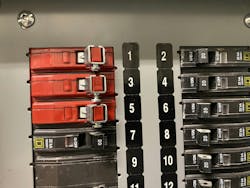What's Wrong Here? Hint: Wrong Receptacle Layout
How well do you know the Code? Think you can spot violations the original installer either ignored or couldn’t identify? Here's your chance to moonlight as an electrical inspector and second-guess someone else's work from the safety of your living room or office. Can you identify the specific Code violation(s) in this photo? Note: Submitted comments must include specific references from the 2023 NEC.
Hint: Wrong receptacle layout
Tell Them What They've Won…
Using the 2023 NEC, correctly identify the Code violation(s) in this month's photo — in 200 words or less — and you could win an Arlington Industries 18-in. Slider Bar and plastic box for mounting between studs with non-standard spacing. E-mail your response, including your name and mailing address, to [email protected], and Russ will select three winners (excluding manufacturers and prior winners) at random from the correct submissions. Note that submissions without an address will not be eligible to win.
March Winners
Our winners this month were Gabe Kaprelian, an electrical contractor from Valley Glen, Calif.; Richard B. Everett, an EC&M reader from Hamilton, N.J.; and Juan C. Hernandez, a contest participant from Germantown, Md. They were able to correctly cite Code violations in this photo.
Section 760.121(B)(5) permits the fire alarm branch-circuit disconnecting means to be secured in the “on” position; however, Sec. 240.24(A) requires circuit breakers to be readily accessible, and “circuit breaker locks” that require the use of a screwdriver to remove do not provide for a circuit breaker that will meet the Art. 100 definition of “readily accessible.” The red paint used to mark the fire alarm circuit breakers creates a violation of Sec. 240.83(A) because the ampere rating of the circuit breakers is completely obscured by the paint. Section 760.121(B)(4) requires the branch circuits for fire alarm equipment to have red identification; however, that red identification must not obscure any manufacturer’s markings. The red paint used on those three circuit breakers is not Code-compliant.
About the Author

Russ LeBlanc
Owner
Russ started in the electrical trade as an apprentice in 1985. He worked his way up to become a Journeyman Electrician and then eventually became a Master Electrician and Licensed Construction Supervisor. In 1999 Russ become an Electrical Instructor for The Peterson School of Engineering in Massachusetts where he developed his passion for teaching, and quickly became Department Head of Electrical Instruction. Russ has taught thousands of apprentices, electricians, engineers, inspectors, and other electrical professionals during his career as an instructor. He continues to provide electrical professionals with Electrical Code seminars, Arc-Flash Awareness training seminars and educational material through his LeBlanc Consulting Services in North Reading, MA whose specialty is educating electricians. He has been an active member of the NFPA Electrical Section and has authored hundreds of National Electrical Code proposals and comments which have become Code rules to improve the safety for the electrical industry. Russ is also an IAEI certified Electrical Inspector.
Please visit www.russleblanc.net for more information.


